
What B2B content marketing do you create?
Is the content as effective as you would like it to be?
If you’re a B2B marketer who isn’t investing in content creation, you’re in the minority — 88% of B2B marketers surveyed by Content Marketing Institute and Marketing Profs said their organization used content marketing to further their goals in 2017.
Developing a sound content marketing strategy is worth it: Hubspot found that B2B companies that blogged 11+ times per month had almost 3X the traffic as companies that blogged only once per month.
B2B companies are more than willing to spend large sums supporting their marketing plan throughout this year. GroupM predicts that the total marketing services expenditures worldwide will past the $1 trillion thresholds for the first time in 2017. 29% is the average proportion of the total marketing budget that is spent on content marketing. And 39% percent are planning to increase their content marketing spending over the next twelve months.
This Year’s B2B Content Marketing Top Performers At-A-Glance
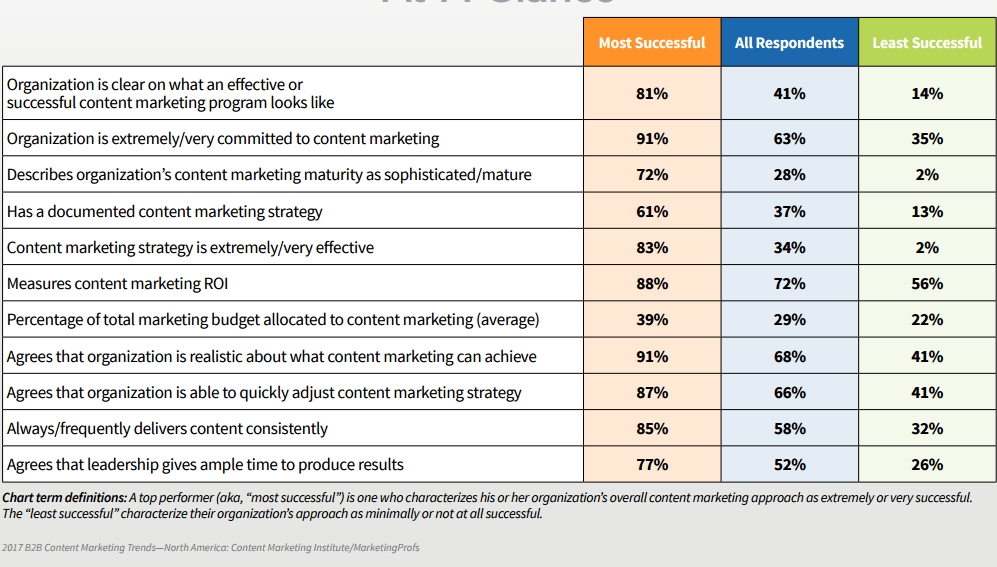
Does your organization use content marketing?
Content marketing is defined as “a strategic marketing approach focused on creating and distributing valuable, relevant, and consistent content to attract and retain a clearly defined audience—and, ultimately, to drive profitable customer action.”
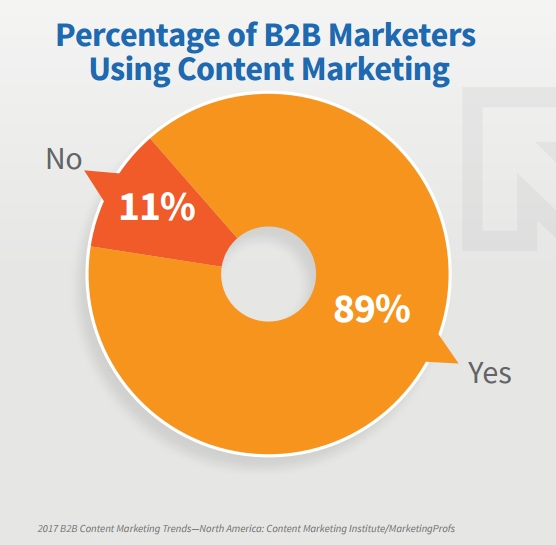
WHY CONTENT MARKETING?
Most older marketing and advertising strategies have been based on short-term gains. For example, a direct mail piece might convert a handful of recipients, but once it’s sent out, most of the batch gets thrown away and the design is scrapped in favor of next year’s model. A billboard might work well for a few months, but eventually, the design will grow tiresome, and you’ll need to purchase new space to see another influx.
There’s nothing inherently wrong with this approach, especially if you’re seeing a positive ROI, but if you want to be successful in the long term, you’ll need a strategy with a little more staying power.
Inbound marketing strategies, like SEO and social media marketing, are effective in producing a slow build of results, but for my money, there’s no better long-term strategy than content marketing.
Content influences almost every other online strategy
WHY?
- It attracts new traffic.
- It builds your reputation.
- It can influence conversions.
- It can make you a separate stream of revenue.
- It encourages trust and faith in your brand. When a visitor stumbles on your site for any reason, your content can secure his/her confidence in your brand, so long as that content is authoritative, helpful, and well-written overall.
Evergreen content lasts forever
They call it “evergreen” content because it never decays. Trendy content, news content, and other forms of “in the moment” material are all important, and tend to attract a lot of visitors, but some forms of content will always be relevant.
For example, people will always need to know tips for better communication, or advice on how to travel efficiently. There may be new elements to some of these features as new technologies develop, but you can always spruce up old posts with a few new tidbits as relevant. Because content can theoretically last forever, it never loses value, making it a perfect long-term investment.
How B2B Marketers Assess Their Organization’s Content Marketing Maturity Level
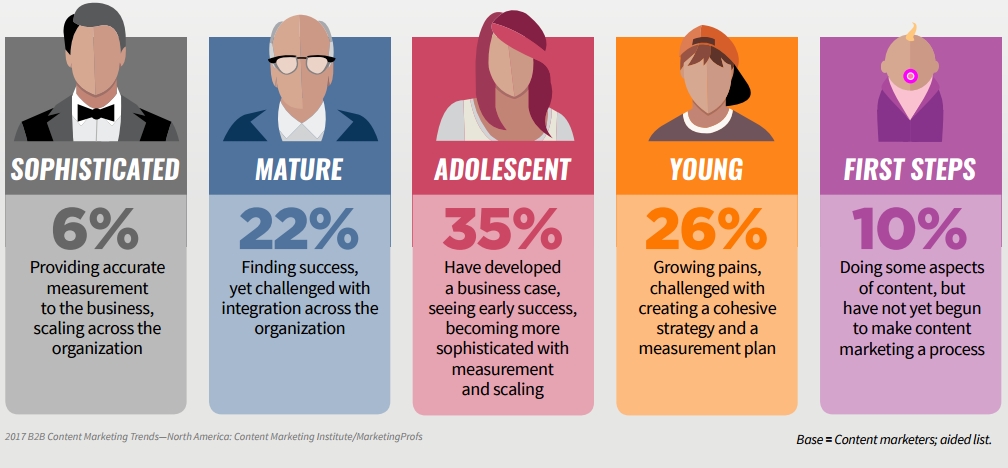
What factors do you attribute your organization’s increase in overall success?
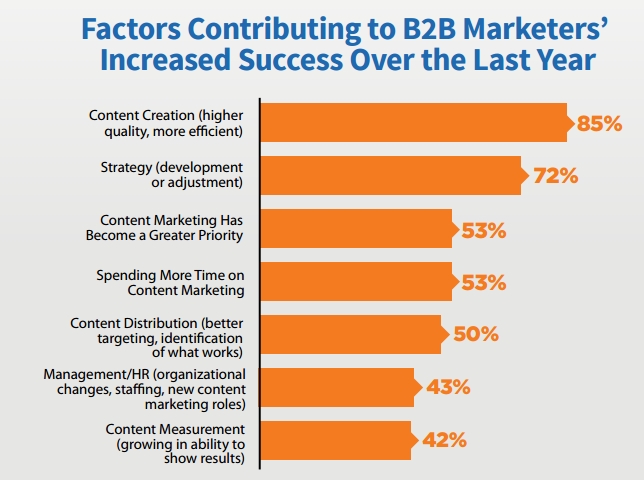
Common Reasons Why Content Marketing Isn’t Working for You
1. You haven’t refined your strategy.
Like any other form of marketing, you need a strategy if you expect to be successful.
I’ve been surprised at how many businesses lack a strategy for their content marketing.
A strategy is crucial for success. Let me provide a few tips related to developing strategy.
- A successful content marketing strategy starts with defining your KPIs (key performance indicators). Identify what numbers are important to you (e.g., views, shares, traffic, CTRs, conversions, etc.), and track them.
- Strategy should change over time. You should change your strategy when you realize that what you’re doing is not as effective as it could be.
- Don’t rely on a content marketing company to make your strategy for you. There are plenty of content marketing companies out there, but they don’t usually get involved in strategy. That’s your job. Their job is to sketch out your editorial calendar, to write your content, and to help you publish. They implement the strategy that you come up with.
- Publishing content is not a strategy. Content marketing strategy takes in the big picture of marketing — audience, revenue, profit, and brand. Deciding to have a blog and write articles is not a strategy.
2. You don’t spend much on content marketing.
Companies who spend a lot on marketing are able to grow their markets faster than companies who don’t spend as much.
To put it another way, you get what you pay for. If you want results with content marketing, you need to spend enough money to make a difference.
There’s a lot of money being thrown into content marketing.
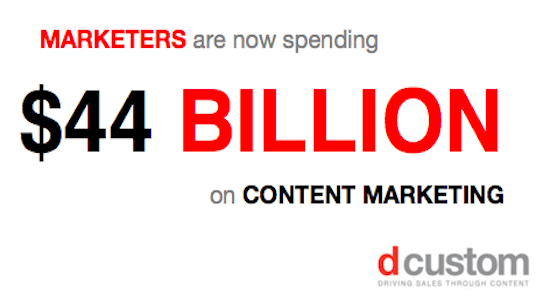
B2B companies with strategic content marketing generate 67% more leads than companies who don’t. You get the picture?
3. You aren’t promoting your content.
The quickest way to kill your content marketing is to do nothing after you create your content.
Let me explain.
Some marketers think that “content marketing” is simply creating content. Then what? Well, users will find the content, right? Organic traffic will increase, people will read it, convert, and we’ll get more customers, right?
Wrong!
Creating content is only part of content marketing. The other half is promoting it. I saw this as a problem a long time, ago, when I gave this advice to businesses: “Don’t forget the ‘marketing’ in content marketing.”
Let’s break apart content marketing into its two main components parts:
- Create content.
- Promote content.
Which of those two are you doing or not doing? If you do a lot of promoting, but just a little of creating, then you are probably more successful than a company who does a lot of creating, but very little promoting.
Content promotion is just as important as content creation.
How do you promote your content? Here are a few easy ways to promote a single blog post:
- Email newsletter.
- Marketing email to a landing page.
- Tweets. Be sure to tweet it several times, and ask for retweets.
- Google+ posting.
- Facebook posting.
- Sharing in LinkedIn.
- Pitch influencers in your industry who can share your content.
- Pitch bloggers and site owners, and ask them to share your content.
- Mention your content when you comment on other websites and blogs.
The important thing to remember about content marketing is that half the work is creation, the other half is promotion.
Homework: If you aren’t doing any content marketing promotion, adjust your approach to spend a solid proportion of your time on promotion.
4. Your content sucks.
I don’t mean to be rude, but I got to say it. Sometimes, the content just plain sucks.
Content marketing means that you have to produce content, but the quality of that content is of utmost importance. Churning out shoddy content does have an impact on your brand, but it is a negative impact. It makes your brand look bad and perform poorly.
Let me point out a few of the reasons why content sucks:
- You don’t know what kind of content to produce. Nearly every business struggles with how to produce engaging content. Coming up with a theme, topics, angles, and something new is challenging.
- You’re boring. Lots of content out there is mind-numbingly boring. To be truly engaging, content must be in-depth, valuable, focused, and well-written.
Since everyone today is doing content marketing, it’s harder than ever to stand out in a crowded content marketing.
If you want to succeed, you need to produce better content than the average content marketer. It’s not easy, it’s not cheap, and it won’t happen overnight.
Homework: Make a list of five things you can do to create better content.
FINAL THOUGHTS
As new technologies and new trends permeate the marketing landscape, the form and function of content will evolve. Already, video is starting to overtake written content in terms of popularity, and just a few years ago, semantic, long-tail topics overtook their keyword-focused counterparts in importance. But no matter what happens, content will always be relevant–all that changes is the way it is produced and the way people access it.
Content marketing may be a long-term strategy, but the sooner you start investing in it, the sooner you’ll start seeing the benefits–and conversely, the longer you wait to get started, the longer it will take. If you currently have no content strategy whatsoever, it’s time to establish one. Whether it serves your bottom line independently or as a backbone for your other inbound marketing strategies, you’ll be glad you did.
About Blair

Blair Evan Ball is a Social Media Coach and founder of Prepare1, a company that works with businesses, individuals and non-profits. He is a former executive with a Fortune 50 company, and his national division did $1Billion+ in sales annually.
Blair has written three e-books: Facebook for Business Made Easy, Facebook Pages for Business Made Easy, and WordPress Blog Setup Made Easy.
Blair also educates, trains entrepreneurs and business professionals how to amplify their brand, increase revenues, and raise more funds.
![[Study] How Will Businesses Change Their Social Media Activities 5 Golden Rules for Sharing on Social Media](https://www.prepare1.com/wp-content/uploads/2014/03/COACH-logohat-162x300.jpg) The Race is ON! | PREPARE | Get into the Game and WIN!
The Race is ON! | PREPARE | Get into the Game and WIN!











Comments on this entry are closed.